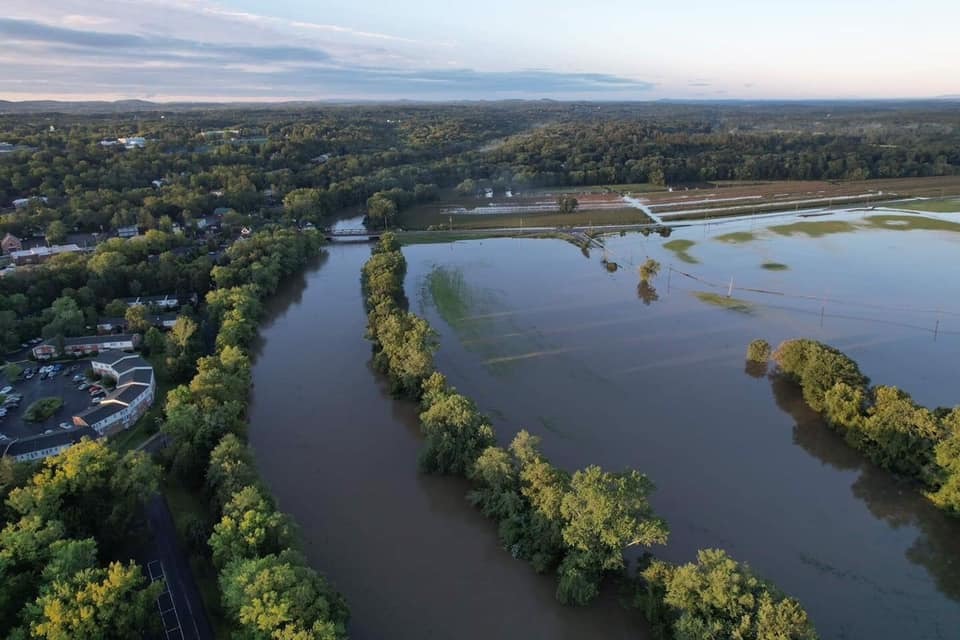New Paltz, NY (April 21, 2022) — With up to 200,000 runners, walkers, and bikers enjoying the Open Space Institute’s (OSI’s) River-to-Ridge Trail in New Paltz each year, visitors are likely unaware of the series of projects seamlessly integrated into the trail and landscape aimed at enhancing the natural benefits of the land.
Since the opening of River-to-Ridge in 2018, OSI has implemented a tailored land management plan for the site which optimizes the six-mile loop trail and the surrounding 360-acres of OSI-protected land for recreational, ecological, and agricultural uses. These management practices offer critical wildlife habitat, improve the water quality of the nearby Wallkill River, and support regenerative agriculture practices that create soil rich in carbon and nutrients.
“Each year, OSI evaluates the River-to-Ridge property to see how we can better improve the management of the land for people and wildlife,” says Wil Nieves, OSI’s Southern New York Stewardship Manager. “Our land management plan integrates sustainability best practices and is supporting the ecological health of the land and soil, improving grassland habitat for local birds species, and implementing natural solutions that improve water quality.”

A Cornell-certified soil health specialist, Wil is able to advise farmers on best practices that comply with the New York State Soil Health and Climate Resiliency Act. His skills have been invaluable since the River-to-Ridge Trail runs alongside active agricultural operations and parts of the property are leased to local farmers.
In advance of this year’s growing season, OSI is working with one leasee, Full Moon Farm, to transition flood-prone sections of the land to organic, no-till hay production, which improves soil health, water infiltration, and and the ability of the soil to store carbon.
OSI’s partnership with Full Moon Farm also includes invasive species removal, the strategic redistribution of topsoil, and a change in field mowing schedules. The changes will allow Full Moon Farm to use River-to-Ridge lands to establish an organic crop that will eventually be used as feed for grass-fed beef and organic dairy cattle.
The projects are in-line with a regenerative agricultural approach to land management which leverages green practices to improve water quality, enhance ecosystem biodiversity, and promote carbon storage in the soil to help mitigate the effects of climate change, among other benefits.
“Our goal is to improve the health of the land holistically while preserving the agricultural heritage of the region,” says Wil. “These practices have tangible benefits for local farmers, trail users, and especially the plant and animal life who call the trail home.”
Chief among wildlife to benefit from these changes are pollinators and ground-nesting birds. For the third year in a row, OSI has enhanced native wildflower meadows along the River-to-Ridge Trail to support native pollinators and insects. When allowed to grow without human interventions, such as mowing, the wildflower meadows add scenic value to the trail and also provide habitat for several key animal species.
Year-after-year, bird species, like the Bobolink, have been spotted in the meadows and grasslands of the River-to-Ridge Trail. OSI is actively monitoring and shifting field mowing plans to accommodate the Bobolinks’ known nesting schedules and help the bird species thrive.

Known for their beautiful, undulating trill, Bobolinks are a type of migratory, ground-nesting songbird. The birds build their nests on the ground in grasslands, meadows, and hay fields, and in recent years, the decline in numbers of Bobolinks have been tied to habitat loss.
“Each year our management plan is building on past successes so that River-to-Ridge can be a gold standard of green trail design and management practices. And we are excited to see the positive effects our management is having on the overall health of the land, wildlife, and the surrounding community,” says Peter Karis, OSI’s Vice President for Parks & Stewardship, who oversaw the design and completion of the trail.
Lastly, OSI trail management projects have focused on improving the land’s natural flood-mitigating properties. With nearly two miles of waterways that flow through the property and into the Wallkill River, managing the flow of water was especially critical in the construction of the River-to-Ridge Trail.
Flood management was a strategic part of OSI’s plan for the land, says Peter, “Flooding of the River-to-Ridge Trail was a question of WHEN, not if. But we knew when we protected, designed, and manged these lands that it would be better for the trail to be underwater than neighboring homes and businesses.”

In the past six months, three major flooding events have caused the Wallkill River to substantially overflow. But the River-to-Ridge Trail was built, specifically, to withstand and accommodate these flooding events while minimizing damage to local communities and to the trail itself.
This year, OSI focused on optimizing the infrastructure it had installed along the trail previously. To improve water drainage along the trail, all drainage ditches and major culverts were cleared of excess vegetation and fallen trees.
While small challenges are bound to occur in the ongoing management of any community trail, Peter is optimistic that the green practices being implemented along the River-to-Ridge Trail are well suited to support the site, the larger landscape, and surrounding communities. “The River-to-Ridge site is so truly unique in that the trail lands are designed to help recreational users, agricultural practices, and wildlife all coexist on this one, critical juncture of land that bridges the city of New Paltz and the Shawangunk Ridge. And OSI’s management of the land is the ‘secret sauce’ that is helping these different usage types all come together.”
